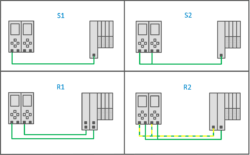Redundancy is a requirement in many process automation systems. Four PROFINET system redundancy configurations have been defined by PROFIBUS & PROFINET International: S1, S2, R1, and R2. First, S or R denotes whether a PROFINET node implements either a Single or a set of Redundant Network Access Point (NAP). Then, the number following S or R determines the number of ARs the PROFINET node supports on each NAP.
An S1 configuration refers to the connection of a single interface module in an IO device, which establishes one AR with a controller. The IO device connects to the automation system via only one communication connection.
PROFINET System Redundancy S2:
System redundancy S2 refers to the connection of a single interface module in an IO device, which establishes one AR with each of the two IO controllers in the system. The IO device connects to both IO controllers via two communication connections (one to each controller).
Redundant PROFINET Configuration R1:
A redundant PROFINET configuration R1 refers to the connection of an IO device via two interface modules. Each one of them establishes one AR with one controller in the system. The advantage of having a redundant PROFINET configuration R1 is that the IO device uses two interface modules to communicate over two separate PROFINET networks (subnets).
Redundant PROFINET Configuration R2:
A redundant PROFINET configuration R2 refers to the connection of an IO device via two interface modules, whereby each one of them establishes two ARs with one IO controller in the system. The IO device uses two interface modules to communicate over two separate subnets. There are 4 ARs in this configuration. Failure of both controllers and/or complete failure of the IO device (both interface modules) cause complete failure of the system.
Read the full white paper HERE:
-Nelly Ayllon

